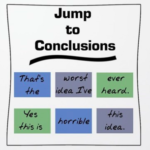Don’t Jump to Problem Conclusions
As a software developer, you want to solve problems.
The code you are writing would be meaningless if it didn’t.
However, if you aren’t the target market you are serving, you may assume a solution is needed before the problem is defined.
Before you try to solve a problem, make sure it’s a problem people in your target market actually care about. Even if you are the target market, never assume what you think is a big problem for your target market without asking them first.
This problem extraction can be a grind, but defining it’s weight and nuance now can save you months of wasted time trying to build a solution for a problem that the market doesn’t value later.
So how can you avoid the fate of building the next checklist app that will inevitably fail? Get out there and ask them.
Ask Your Market What Their Problems Are
It sounds simple, and it is but it’s remarkable how often a solution is created before the problem is fleshed out.
One of my favorite questions is, if you could wave a magic wand to solve a problem you face in your business, what problem would you solve.
This is a lot more effective than stating a problem you think exists and then receiving false-positive feedback that may lead you to believe the problem is something they *really* want to solve and value.
is a lot more effective than stating a problem you think exists and then receiving false-positive feedback that may lead you to believe the problem is something they *really* want to solve and value.
Instead, frame your questions so they are open-ended. Better yet, give them a framework to work with, e.g. “If you could wave a magic wand to solve problems facing your web development team, what would that be?”
During the early stages of your problem extraction, you should go as deep as possible to gain understanding. Continue to ask why and dig deeper with a” So What?” perspective that gets to the root issues of a problem.
You may also ask them to rank order the problems they share to get a stronger signal about their relative importance.
Get Meaningful Qualitative and Quantitative Data
After you get enough free response feedback, you should start incorporating more quantitative feedback.
During your discovery phase, you’ll want to be consistent. If you’re not being consistent with the set of questions you ask, you won’t be able to get a true baseline of what the market as a whole thinks.
Ask a handful of the top-level questions you’ll always want to ask each prospective audience. Don’t worry, I’d always encourage you to push further with the whys, but you need a baseline to build from.
Certain questions are ripe for you to dig deeper to reveal insights, but once your qualitative questioning is ironed out, you can get better data by asking some of your questions in a more quantitive way.
For example, instead of an open-ended question that allows for a free response, use a Likert scale that defines how strongly an opinion or statement rings true. This quantitative data will be useful to see what problems you should solve first.

As an anecdote, sending a quantitative follow-up survey to determine the relative passion for problems or features has been extremely useful for prioritizing development sprints so you’re product meets your target audience where they are today.
What problems does your target market need solving?